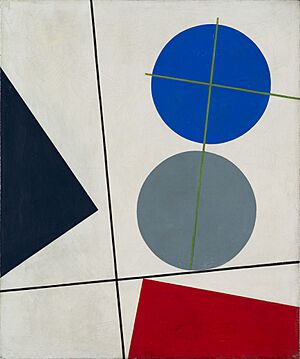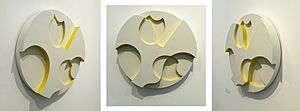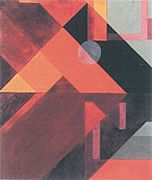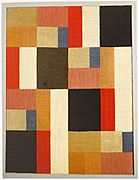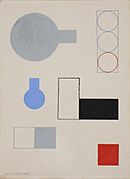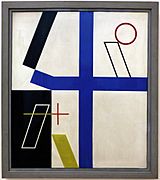Sophie Taeuber-Arp facts for kids
Quick facts for kids
Sophie Taeuber-Arp
|
|
|---|---|
 |
|
| Born |
Sophie Henriette Gertrud Taeuber
19 January 1889 Davos Platz, Switzerland
|
| Died | 13 January 1943 (aged 53) |
| Nationality | Swiss |
| Education | Gewerbeschule in St. Gallen, Dschebitz-Schule in Munich, and Kunstgewerbeschule in Hamburg |
| Known for | Sculpture, painting, textile design, dancing |
| Movement | Concrete Art, Constructivism, Dada |
| Spouse(s) | Jean Arp |
Sophie Henriette Gertrud Taeuber-Arp (born January 19, 1889 – died January 13, 1943) was a super talented Swiss artist. She was a painter, sculptor, textile designer, and even a dancer! She also designed furniture, interiors, and was an architect.
Sophie was born in Davos, Switzerland, in 1889. She grew up in Trogen. She went to a trade school in St. Gallen and then to art schools in Germany. She moved back to Switzerland during World War I. In 1915, she met the artist Jean Arp, and they got married later.
During this time, Sophie and Jean became part of the Dada art movement. This movement started in 1916. Sophie Taeuber-Arp's famous work, Dada Head (Tête Dada; 1920), comes from these years. In 1926, they moved to France. They lived there until World War II, when they returned to Switzerland. Sophie died in 1943 due to an accident with a gas stove.
Even though she was not always famous after her death, Sophie Taeuber-Arp is now seen as one of the most important artists. She was a leader in concrete art and geometric abstraction in the 20th century.
Contents
Sophie's Early Life and Training
Sophie Henriette Gertrud Taeuber was born in Davos, Switzerland. She was the fifth child of Emil Taeuber, a pharmacist, and Sophie Taeuber-Krüsi. Her father died when she was two years old. After that, her family moved to Trogen, Switzerland. Her mother opened a guesthouse there. Sophie learned to sew from her mother.
She studied textile design at a trade school in St. Gallen from 1906 to 1910. Then, she studied at art workshops in Munich in 1911 and 1913. She also spent a year at the School of Arts and Crafts in Hamburg. In 1914, she returned to Switzerland because of World War I.
In 1915, she joined the Swiss Werkbund, a group for artists and designers. That same year, she went to the Laban School of Dance in Zürich. She also joined an artist group in Ascona. In 1917, she danced with other artists at a festival in Ascona. From 1916 to 1929, Sophie taught embroidery and design at the Zürich Kunstgewerbeschule in Switzerland.
Sophie and the Dada Movement
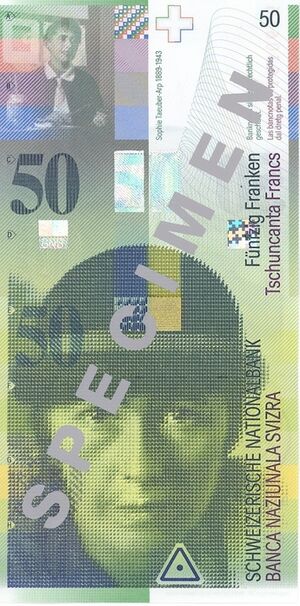
In 1915, Sophie met Jean Arp at an art exhibition. Jean Arp was a Dada artist who had moved to Zurich to avoid fighting in World War I. Sophie and Jean worked together on many art projects. They got married in 1922, and she changed her name to Taeuber-Arp.
Sophie taught weaving and other textile arts at the Zurich University of the Arts from 1916 to 1929. Her textile and graphic works from this time are some of the first Constructivist artworks. These artworks use simple geometric shapes and colors in a clever way.
During this period, she was very active in the Zurich Dada movement. This movement was based at the Cabaret Voltaire. Sophie performed in Dada shows as a dancer and puppeteer. She also designed puppets, costumes, and sets for these shows. In 1917, she danced to poetry while wearing a special mask. A year later, she signed the Zurich Dada Manifesto. She used Dada ideas in her dancing, which was described as unique.
She also made sculptures, like her abstract "Dada Heads." These were made from painted wood and looked a bit like hat stands. They showed how she combined fine art with everyday objects.
Sophie Taeuber-Arp was also friends with Tristan Tzara, a famous Dada poet. In 1920, Tzara asked many Dada artists, including Sophie, to contribute to a book called Dadaglobe. The book was meant to be a collection of Dada art and writing, but it was never published.
Many people say that Sophie's Dada art was "joyous." It used blocks and blobs of color and let patterns appear by chance. This playful approach challenged traditional art rules.
Life and Art in France
In 1926, Sophie Taeuber-Arp and Jean Arp moved to Strasbourg, France. They became French citizens. They spent their time between Strasbourg and Paris. Sophie got many jobs designing interiors. For example, she designed a modern, geometric interior for the Café de l'Aubette. Jean Arp and Theo van Doesburg also helped her with this project.
From the late 1920s, she lived mostly in Paris. She kept experimenting with design. In 1928, she designed their new house and some of its furniture outside Paris. She showed her work at art exhibitions in Paris in 1929–30.
In the 1930s, she joined art groups like Cercle et Carré and Abstraction-Création. These groups promoted non-figurative art, which means art that doesn't show real objects. Sophie also designed the cover for an art magazine called transition in 1933.
Sophie Taeuber-Arp often used circles in her art. She saw the circle as a symbol for the universe. She called her works from this time "ping pictures." She might have been the first artist to use polka dots in fine art, like in her work Dynamic Circles from 1934.
Later, she started an art magazine called Plastique (Plastic) in Paris. Her friends included famous artists like Sonia Delaunay, Wassily Kandinsky, and Marcel Duchamp. She was also part of a Swiss painters' group called Allianz. In 1940, Sophie and Jean Arp left Paris because of the war. They moved to Grasse, where they formed an art group with other artists. At the end of 1942, they went back to Switzerland.
Death and Lasting Impact
In early 1943, Sophie Taeuber-Arp died in an accident. She was staying in a summer house and died from a problem with a stove.
The famous artist Wassily Kandinsky said that Sophie Taeuber-Arp used simple, geometric shapes in her art. He said her art was quiet but very expressive and convincing.
In 2014, a photo of Sophie dancing in a special mask and costume at the Cabaret Voltaire in 1917 was shown at an art exhibition in France.
Sophie Taeuber-Arp was honored on the Swiss 50-franc banknote from 1995 to 2016. She was the only woman on that series of banknotes.
A museum dedicated to Sophie Taeuber-Arp and Jean Arp opened in 2007 in Germany. On January 19, 2016, Google created a special Google Doodle to celebrate her 127th birthday.
Exhibitions and Recognition
Sophie Taeuber-Arp showed her art in many exhibitions. In 1930, she was part of the first Carré exhibition in Paris. In 1943, her work was shown in an exhibition called Exhibition by 31 Women in New York. Many museums around the world have her art.
For many years, her husband, Jean Arp, was more famous. But after World War II, Sophie Taeuber-Arp started to get more recognition. Her work is now seen as very important in modern art. A big exhibition of her work was held in 1955.
In 1981, the Museum of Modern Art (MoMA) in New York held a large show of her work. This show then traveled to other museums.
In 2016, an exhibition called "Dadaglobe Reconstructed" was held. It brought together over 100 artworks that were supposed to be in Tristan Tzara's Dadaglobe book, including works by Sophie Taeuber-Arp. This show was at the Kunsthaus Zürich and the Museum of Modern Art.
In 2020, an online exhibition of her work opened. A major traveling exhibition of her work is planned for 2021. It will show over 400 pieces and will be her biggest exhibition in the UK and America in 40 years.
Gallery
See also
 In Spanish: Sophie Taeuber-Arp para niños
In Spanish: Sophie Taeuber-Arp para niños



